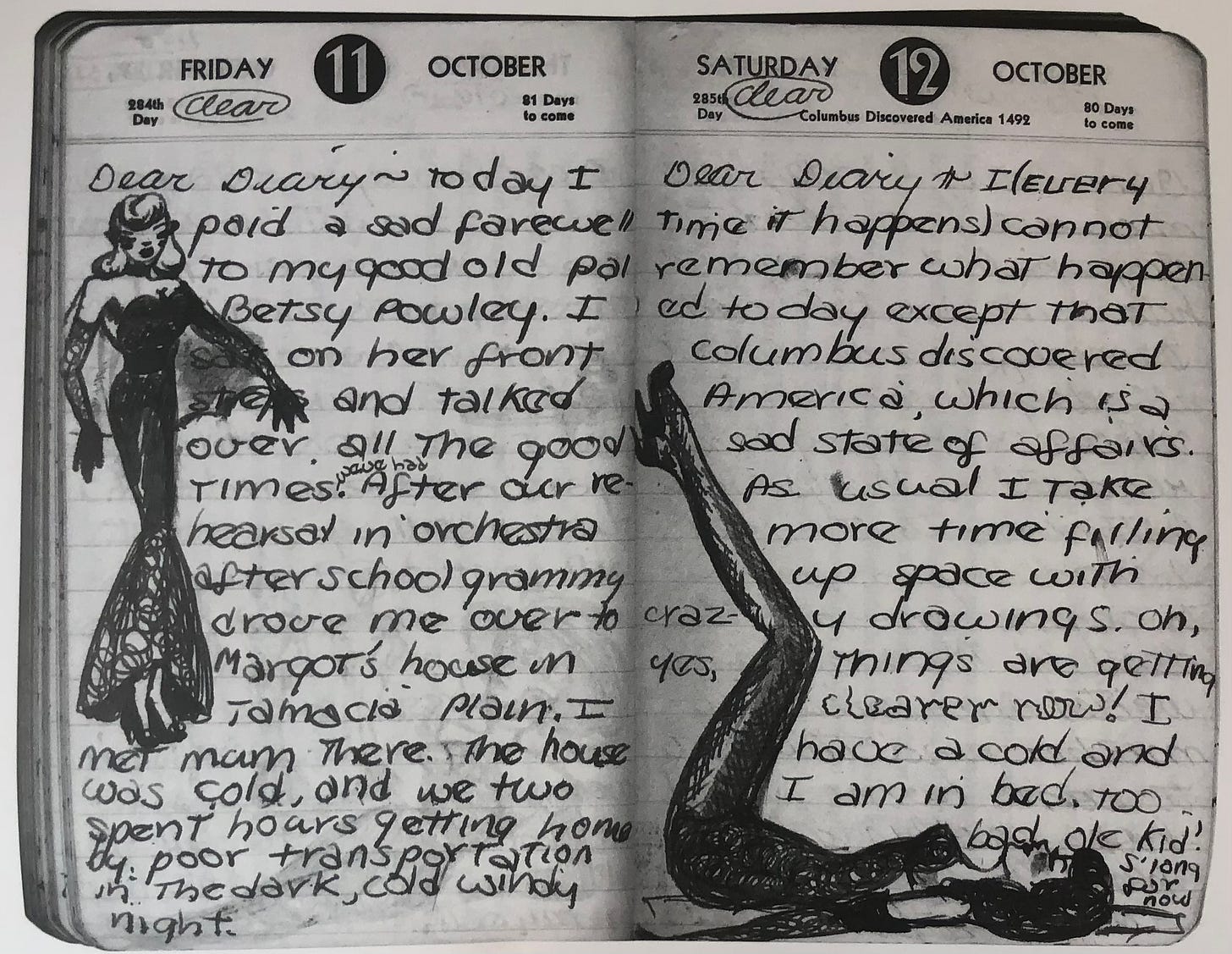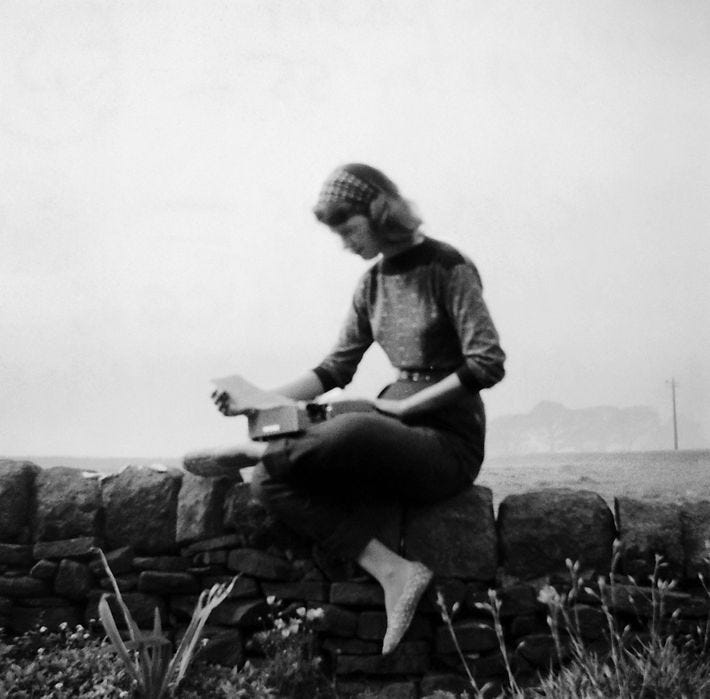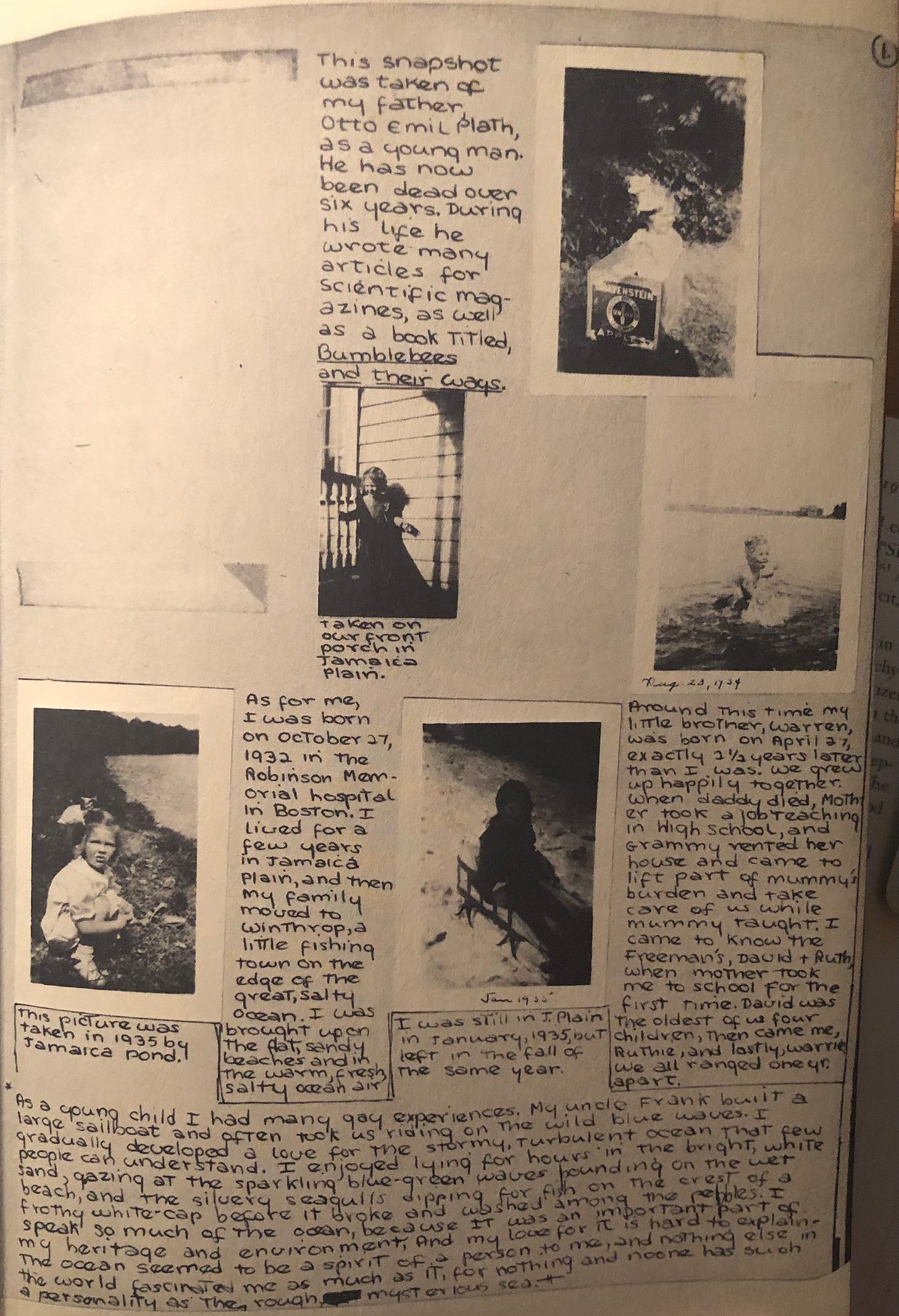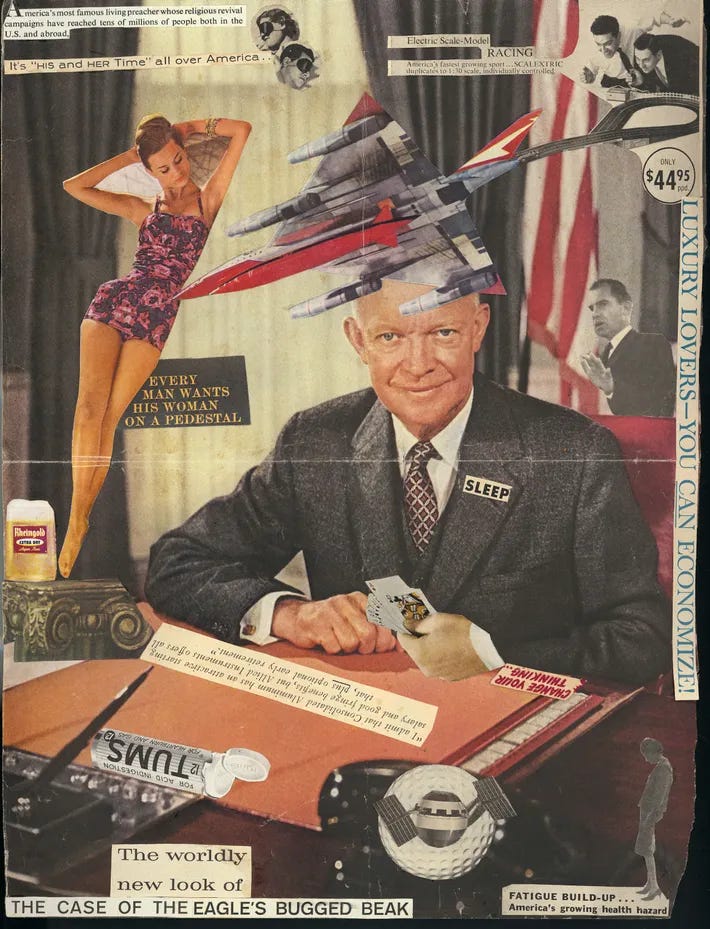Re-Noted: Sylvia Plath's Visual Notes
"As usual I take more time filling up space with crazy drawings."
Here’s something I’ve learned from studying notebooks: often, creative people are creative across multiple mediums. Take Sylvia Plath (1932-1963) for example—she was a brilliant writer and a talented visual artist.
Not only did Plath fill her diaries with sketches, she created elaborate scrapbooks to document her life. She painted striking pieces of abstract art. She expressed her political views in a collage with Eisenhower’s face at its center. She was obsessed with the color red.1
Plath’s Diaries
Plath kept notebooks to keep track of her life. In a journal, she wrote:
It’s hopeless to “get life” if you don’t keep notebooks. I am angry now because, except for the snow, I forget what the trip from France to Munich was like.2
Sylvia used both literary and visual arts to “get life” —to capture it, remember it, and turn it into art.
Plath is one of history’s great diarists. She began to record her thoughts at age 10 and continued until her death at 30. As she matured, her subject matter changed. At first, she discusses friendships and cute boys. Then, she reflects on her school work and her ambitions:
So much working, reading, thinking, living to do. A lifetime is not long enough.3
Later, she used her diaries to try to discipline her work habits.
See each scene deep, love it like a complex faceted jewel. Get the light, shadow & vivid color. Set the scene the night before. Sleep on it, write it in the morning.4
You can read about five of Plath’s strategies for getting work done here. This post, however, is all about the visual arts and Plath’s gorgeous creations.
In one of her early diaries, Plath acknowledges,
As usual I take more time filling up space with crazy drawings.5
A pin-up doll’s legs stretch up the margin and cut into the word “crazy”:

Plath was a talented illustrator. Here, she describes a summer day spent with friends. They played Monopoly and ate their meals outside. Sylvia and her friend Ruthie worked on getting “glamorous tans.” Plath illustrates the four friends, and sketches herself in a bathing suit.
At the top of the page, someone has written two key words: “Robin” and “David F.”—the first refers to a bird that Plath describes getting a “juicy worm.” David is one of the friends—he shows up “taller, better looking” than Sylvia remembered.
Plath’s Sketches
Paper, it seemed, called out for Plath’s illustrations. Even while studying “The Influence of the War on American Life” and “Our Part in the Peace” at school, Plath couldn’t help but draw a fashionable 1950s lady:

Notice how Plath crossed out the two sections titled “Things to be done by pupils working for additional credit.”
Plath’s Photographic Autobiography
In high school, Plath set out to write her autobiography with photographs.
Sylvia’s father, Otto Plath, died when she was young. So, it seems fitting that his photograph would also have disappeared, leaving a ghostly blank space next to Sylvia’s description. Otto was an expert on bumble bees and “wrote many articles for scientific magazines.”6
Much of Plath’s early personal writing is occupied with romantic interests. Consider this page of her photographic-autobiography—here, she writes about sending “long fat letters with little colored pictures in the margins” to a crush:
And so there comes a time in your senior year at high school when, because you like the ocean and the wind and sound, someone grins and drives you down to the sea; and because you like poetry, someone gives you a poetry anthology for graduation; and because that someone is collegiate and quite lovely, you invite him to your senior prom and write to him every day for a whole summer. Long fat letters with little colored pictures in the margins. And no matter how you change or grow up, there was a time when someone was terribly important.7
Plath’s Political Collage
If you want to know more about Plath, read Heather Clark’s biography: Red Comet: The Short Life and Blazing Art of Sylvia Plath. It’s wonderful!
One particular section stayed with me. Here, Clark describes Sylvia’s Eisenhower collage of 1960 as a representation of Plath’s leftist politics and the themes she would explore in The Bell Jar. Clark writes:
Had this collage been on the novel’s first cover, The Bell Jar, considered “an unhealthy celebration of death” by some, might have been read in a different way—its author more Beat than beaten down. It has survived to give us a deeper sense of the anti-military, anti-patriarchal, and anti-American feelings Plath possessed as she embarked on her novel in 1961.8
This collage, as Clark points out, explores America’s cold-war politics, the military-industrial complex, and misogyny.
While The Bell Jar is based on Plath’s year working for Mademoiselle in New York City, and her time at McLean Hospital, it is also a political novel. It’s easy to forget that it begins with the Rosenberg’s execution:
It was a queer, sultry summer, the summer they electrocuted the Rosenbergs, and I didn’t know what I was doing in New York.9
Plath’s Painted Objects
And, finally, among Plath’s artistic endeavors, I found this cradle especially moving. Her husband, Ted Hughes, built the cradle, and Plath painted it for their daughter, Frieda, to play with.
Incidentally, Frieda Hughes is a talented writer and painter, just like her mother.

Notes on Plath’s Notes
Illustrate your writing: Plath filled her diaries and letters with illustrations. For her, painting and poetry reinforced one another. There’s considerable historic precedence for the two sister arts. Consider Horace's Ars Poetica, which includes the line: “ut pictura poesis” (“as is painting, so is poetry”) ...10
Create a multi-media autobiography: Remember the days of photograph albums—made with real paper and bound in gilded leather covers? I suppose we can create our own photographic autobiographies digitally. But, call me old fashioned, there’s something especially meaningful about holding a photograph in your hand and captioning it with your own handwriting.
Create a collage as a pre-writing exercise: Plath’s Eisenhower collage got me thinking about my own writing process. When I start Noted’s posts, I usually have a handful of images and quotes. So, my drafts look a bit like a collage—albeit certainly nowhere near as gorgeous and powerful as Plath’s. (But, then again, I’m not writing The Bell Jar.)
What about the rest of you? Do you need images in order to write? Or, do you need words in order to draw?
Noted is fueled by you. Your ❤️’s and comments inspire me. As always, I would love to know your thoughts.
Till Monday,
P.S.
Paid subscribers can read about Plath’s writing goals here!
In Plath's final months she used the color red twenty-two times in her poems. Her affection for the color was evident in her prose as well. She cites the color red over one hundred times in her journals, seemingly fixated on its hue, whether writing about "red-skinned apples," "red-lacquered nails," or "Rose leaves red, deep-red tipped.
Poets, Academy of American. What Sylvia Plath Loved | Academy of American Poets. https://poets.org/text/what-sylvia-plath-loved.
Plath, Sylvia. The Unabridged Journals of Sylvia Plath. Edited by Karen V. Kukil, Unabridged edition, Anchor, 2000., p.149.
Journals, p. 273.
Journals, p.268-269.
Connors, Kathleen, and Sally Bayley, editors. Eye Rhymes: Sylvia Plath’s Art of the Visual. Oxford University Press, 2007, p. 46.
Plath, Sylvia, et al. Letters Home by Sylvia Plath: Correspondence 1950-1963. First Edition, Harper & Row, 1975.
Letters Home.
Clark, Heather. Red Comet: The Short Life and Blazing Art of Sylvia Plath. Knopf Doubleday, 2020, p. 653.
Plath, Sylvia. The Bell Jar. HarperCollins, 2015.
This is what Plath wrote in her diary on the night the Rosenbergs were executed:
There is no yelling, no horror, no great rebellion. That is the appalling thing. The execution will take place tonight; it is too bad that it could not be televised…so much more realistic and beneficial than the run-of-the-mill crime program. Two real people being executed. No Matter. the largest emotional reaction over the United States will be a rather large, democratic, infinitely bored and casual and complacent yawn.
Journals, pp. 541-542.
“Sister Arts.” Oxford Reference, https://doi.org/10.1093/oi/authority.20110803100508889.










There's truly nothing like "meeting" a writer through their own handwritten diaries, with the added treat of illustrations in the margin! THANK YOU Jillian for yet another unique discovery. I can't begin to imagine what it must have felt like to flicker through the pages of Plath's very own diary, so close to her and yet so far.
While I am far from Plath's multiple talents, I do feel inspired and reassured that illustrating my thoughts before writing them down on the page was also something that an author of her standing adopted the process, too. :) Looking forward to your next piece!
The pin-up doll marginalia is so great. She had a lot of talent apparent very early on.